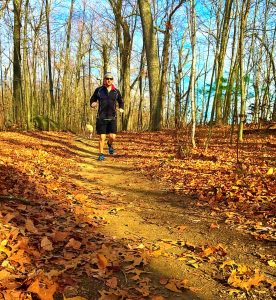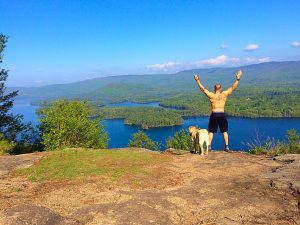
Your first step, find a running trail. This is easier said than done. So where to start…? You have to find the trails to become a trail runner. Ask friends, ask running stores, do your research. Many local parks have trails mapped within them [Maine Friends – Pineland is one of those!, Rhode Island/Massachusetts – Blue Hills is another!]. It’s generally safe to say you can follow trails on the power line routes for miles and miles. Or use the snowmobile and ATV trails to your advantage. You may even be lucky enough to have some single track trails in your backyard. Whatever your destination, pick it wisely. [Salomon Running is a great App for finding some trails in an area.] Note the distance, the elevation, the terrain. Once you are out there, you are out there. That’s the beauty of trail running, that’s also the reason to take the following points to heart.
1) Be Safe: Always tell someone where you are going, what your expected route looks like, and your expected time of arrival back home. This especially holds true if you’re going at it alone. Most trails are going to take you out in the wilderness and into less traveled places. While this brings Instagram-worthy views and sights of awe, it can also be very dangerous. Anything can happen [injury, fatigue, you get a little bit lost, you didn’t see that rock..] — someone needs to have a pretty good idea of where you are. [Side note: Crystal and I run apart most of the time. But, we always check in at the beginning of a run and immediately when we are finished.]
2) Be Prepared: I’m pretty confident that you will not be running by any local convenience stores on your trail running adventures. If you happen to experience this — a word of advice — you picked the wrong trail. Bring a pack that can carry all of your essentials: water, electrolytes, extra clothes such as a rain jacket, socks, hat, gloves, and a buff. [Our adventures include Ultimate Direction packs {found here} filled with extra clothes, Isagenix Fuel: Replenish, AMPED Recover – long runs, Picky Bars, Chia Bars, Salt Tabs, Honey Stinger Waffle Bars.]
3) Select the Appropriate Shoes: If you are considering adding trails into your life, I highly recommend that you also add a good pair of trail shoes. Unlike running on the road, trails are never the same. There are smooth single track trails and then there are technical trails, equipped with nature-made obstacles: rocks, roots, trees, lime stone, mud, water, and the list goes on and on. Trail shoes will provide protection from these elements, will typically dry out faster and give you a more enjoyable time out there. Protect your feet! [Our shoes of choice: Jesse – Altra Lone Peak 2.5’s {found here} and Crystal – Salomon XR Mission & Speedcross {found here}]
4) Run Within Your Means: It is plain and simple — running trails is much different from running on the road. For instance, if you are used to running an 8-minute mile on the road, prepare for a 9.45 – 10-minute mile on the trails. Maybe even a 20-minute mile. The trails are technical, they come with elevation. It’s a dirt and vert world so learn to listen to your body, put your watch away, and if you must walk and slow down for a minute, DO SO!
5) Cross Training: Sure, track workouts and speed work will make you faster, but it won’t necessarily make you a stronger trail runner. The strength comes with time and practice. Maintaining lean muscle is NEVER a bad thing, especially when it comes to navigating tough terrain. Weight lifting, HIIT workouts, biking, hiking, swimming, and yoga are all great training programs to incorporate into your plan to become a better and stronger trail runner. The key to all of this is creating a happy balance. [Need help with this? We are happy to help guide you – click here to send us a request]
6) Learn to Use Your Arms & Glutes: Let’s talk about form. Engage your butt muscles! Keep a high chest, pick up your knees and lead with a leaning body. Keep your arms a little wider out than you would when running on the road. This will help you create balance when navigating rocky/steep terrain. Your running stride, may not present itself, as much of a stride at all, as you will need to hop left or right to avoid something, leap over the huge puddle or fallen tree. Be aware of what is under your feet and use your body to your advantage.
7) Stay Focused: This may sound silly, but lets be honest here, it is easy to become distracted while trail running. You’ll be tempted to look at the colors, the views, the wildlife. But, distracted running can quickly lead you into some bad places. That rock you didn’t see, that tree branch that happened to be at chest level – well, you need to see those things. Keep your eyes on the trail at all times and a pick a view of about 3-5 feet in front of you. Pay attention, this brings me back to number one, be safe!
8) Take Your Time: You do not become a trail runner overnight. You learn as you go, you become stronger as you go. So be patient, soak up the fresh air, take your time. Sand, mud, hills, jumping and dodging tends to take more out of you than you may think. Maybe you have to power hike the uphill and take a slower pace downhill. You have to take enough time to be in control of your body at all times.
9) Recovery: Recovery is the name of the game when it comes to sustaining your new found trailventure love. It can be very tempting to run the trails frequently at first, but you must give your body the proper time to recover. Maybe you don’t “feel” the miles – yes, the trails are a bit more forgiving than the road, but trust me, your body put in the work. Start by adding in a trail run once or twice a week. Slowly progress to two and three times a week or to the miles that best fit your goals. Your goals are always sustained by recovery.
10) HAVE FUN: This is something I can’t stress enough. Don’t worry about your times! Don’t worry about comparing your road times with your trail times. Don’t worry about comparing your trail times with your trail times. All trails are different; there are too many variables to consider right now. Enjoy the outdoors and be at one with nature. There’s a time and a place for everything. This is where you start to learn the meaning of, “it’s much more than sore legs.”
Here are our 10 steps to your first trail adventures. Trail running friends, do you have more tips and tricks to share? Leave your comments!
* * *
From a bodybuilder to OCR fanatic to a beginner runner to an ultra runner…
I didn’t become an ultra runner overnight. I didn’t even become a runner overnight. I started my trail running adventures just about 4 years ago when I signed up for a local OCR race in Rehoboth, Massachusetts — Tuff Scrambler. About a quarter of the way through this race, I stopped for a second (most likely to catch my breath) and thought to myself — this is the greatest thing ever. You’ve had these so called, “AH HA moments” in life, right? From this point on, I was addicted to this style of running [Crystal will point out that her love for trail running, probably has a lot to do with the reason I pushed through many miles in the beginning – because OCR and trail running aren’t exactly the same].
The funny thing is, at one point, I hated running and was entirely passionate about bodybuilding. I still am, I just balance that passion with ultra running and trail running adventures too. Because, it is entirely possible to do both. – Jesse





What do you think?